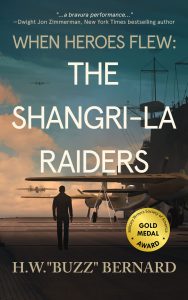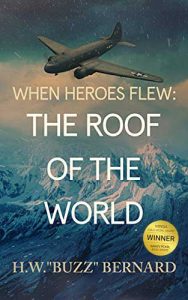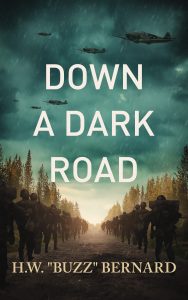When Heroes Flew
 Buy the Book:
Buy the Book:Amazon
Barnes & Noble
IndieBound
Books-A-Million
Waterstones
Fish Pond
Google Play
Published by: Severn River Publishing
Release Date: April 28, 2020
Pages: 288
ISBN13: 978-1951249977
Overview
For B-24 bomber pilot Al Lycoming, the mission was history in the making.
Dispatched to Benghazi on mysterious orders, he finds nearly 200 other B-24 bombers being assembled...and a top secret assignment that will catapult them all into seemingly impenetrable Nazi defenses.
Their mission: a daring low-level attack on Hitler’s extensive oil refineries.
But when his co-pilot falls ill, Albert is forced to secretly find help from an unlikely source—a female pilot who ferried a bomber from America.
Together, the two launch on the most daring bombing raid of WWII...and into the pages of history.
Add on GoodreadsPraise
"Highly recommended."
—P.T. Deutermann, author of PACIFIC GLORY, winner of the annual W.Y. Boyd award for best military fiction
“Strap in! It’s one hell of a ride!”
—Don Keith, award-winning and bestselling author of FINAL BEARING
“World War II angst and action brought to life."
—Commander George Wallace, USN (Ret.), author of the HUNTER KILLER series
"...feel the vibration, smell the exhaust, and sense the fear."
—Tom Young, author of SILVER WINGS, IRON CROSS
"...chuckle and weep in tandem while forgetting everything around you but the story itself."
—Kathleen M. Rodgers, 2019 MWSA Writer of the Year Finalist and author of THE FLYING CUTTERBUCKS
"[The pilot's]...amazing courage, and that of the entire group, is subtly drawn. Five medals of honor were actually awarded that day for that one raid. Sitting in the cockpit with Al Lycoming will tell you why."
—John J. Gobbell, author of the Todd Ingram series
Behind the Scenes
When I began researching the WWII bombing raid that WHEN HEROES FLEW is set against, I thought—happily—there might be a weather connection. (Those of you who know me will recall I’m a weather geek in addition to being a novelist.)
The literature I had access to when I started my research, almost twenty years ago, strongly suggested that weather had played a significant role in causing the raid to become the deadly, screwed-up debacle it became.
But the role of weather turned out to be nonexistent.
On YouTube, I found a video by an Army Air Force pilot, the late Robert Sternfels, who had actually flown the mission. He said the weather factor as described in a popular book about the raid never occurred, that it was made up. And the more I dug into the subject, the more support I uncovered for that notion.
Yep, I’d lost my weather connection, but by then I was so thoroughly engrossed in the subject, the bombing attack on Nazi petroleum facilities, that it didn’t matter. The story of the raid itself had completely captured me.
I hope it captures you, too.
Excerpt
Al, exhausted and hurting and no longer able to fight, surrendered to his fate . . . and found a strange peace. He studied the fighter as it crept closer and closer. Oil continued to stream along its flank, just above the air intake for the supercharger. An antenna mast and a smaller circular antenna—probably a direction finder—sat on top of the fuselage just to the rear of the cockpit. The rear side of the camouflage-painted fighter displayed a large, black German cross. To the rear of the cross, a broad white stripe encircled the fuselage.
Al knew the stripe signified the Mediterranean Theater.
Despite his imminent death, he wondered about the Messerschmitt’s pilot, the man who would be his Grim Reaper. Old? Young? Married? Did he have a son? A daughter? Did he believe in God? Worship Hitler?
In another time, another place, would they have sat down together somewhere on a Saturday evening and swilled beer and swapped stories about flying and showed each other pictures of their families? He of Inge and Christa?
Al turned to stare straight ahead through the splintered windscreen and await the cannon burst that would seal his fate.
#
Egon drifted the 109 ever closer to the shell-riddled Liberator. He continued to marvel that it remained aloft—so much damage. Like all American bombers, it bore a colorful logo on its nose. He didn’t understand the writing, Oregon Grinder, but allowed a smirk to flit across his face at the image of an organ grinder in a top hat with the word “OREGON”—whatever that meant—printed on it, stuffing a fiendish-looking monkey, a cartoon Adolf Hitler, into a meat grinder.
“Ich helfe Dir,” Egon muttered. I’ll help you. But knew he wouldn’t.
He moved the Messerschmitt forward, paralleling the crippled, olive-green bomber. He caught a glimpse of a face in the waist gunner’s window. Then someone flashed a middle finger at him. Apparently that’s all the Americans had left with which to counterattack.
He banked the fighter to the right with a quick flick of his control column, then just as quickly snapped it back to level flight. The face in the window ducked. The obscene gesture disappeared.
Egon maneuvered his fighter into a position just off the Liberator’s left wing tip, placing the Messerschmitt’s right wing tip several feet below and several feet forward of the bomber’s wing. The bomber didn’t alter course. It pushed straight ahead, skimming just beneath the scattered, flat-based cumulus dotting the sky, while at the same time continuing to drop inexorably toward the pristine blue-green swells of the Ionian Sea.
Egon glanced at the belly of the bomber and did a double take.
“Mein Gott,” he exclaimed. What looked for all the world like a sunflower dangled from a shredded piece of aluminum near the bomb bay. Had the Americans flown that close to the earth?
Also in this series:


